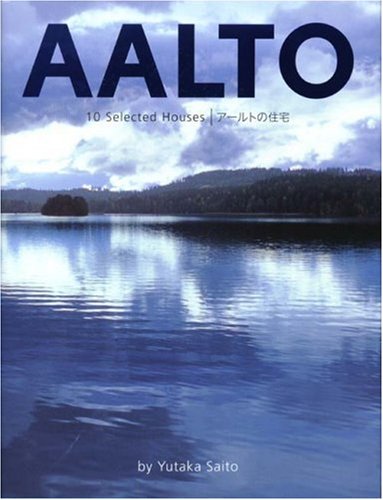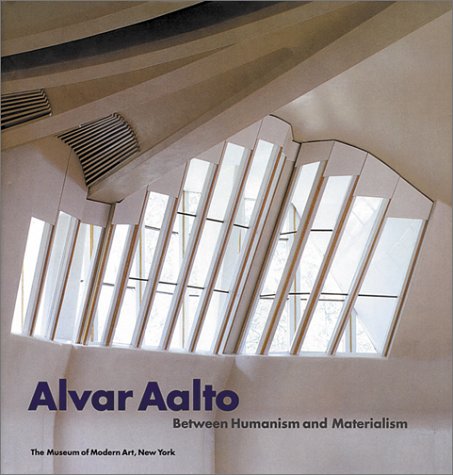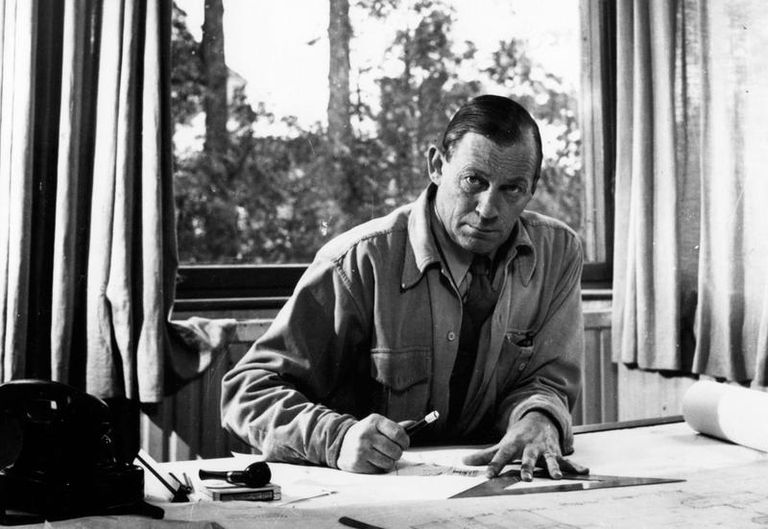Alvar Aalto Biography and Profile
Architect / Finland / Works of Alvar Aalto
Hugo Alvar Henrik Aalto (1898 – 1976) was the best-known Finnish architect of his generation. His work includes architecture, furniture, textiles, and glassware, as well as sculptures and paintings. However, he never regarded himself as an artist, seeing painting and sculpture as “branches of the tree whose trunk is architecture.” Aalto’s early career ran parallel with Finland’s rapid economic growth and industrialization during the first half of the 20th century. Many of his clients were industrialists.
His buildings, such as the Paimio Sanatorium (1933), the legendary Villa Mairea (1939), and the church of the Three Crosses in Vuoksenniska (1958), embody a masterful interplay of organic volumes, forms, and materials.
After qualifying as an architect from the Helsinki Institute of Technology (later Helsinki University of Technology and now part of the Aalto University) in 1921, Aalto set up his first architectural practice in Jyväskylä. His early works followed the tenets of Nordic Classicism, the predominant style at that time. In the late 1920s and early 1930s, he made many journeys to Europe. He and his wife, Aino Marsio, also an architect, became familiar with Modernism’s latest trends, the International Style.
The pure Functionalist phase in Aalto’s work lasted for several years. It enabled him to make an international breakthrough, largely because of Paimio Sanatorium (1929-1933), an important Functionalist milestone. Aalto had adopted the principles of user-friendly, functional design in his architecture. From the late 1930s onwards, Aalto’s buildings’ architectural expression became enriched by using organic forms, natural materials, and increasing freedom in the handling of space.
It was characteristic of Aalto to treat each building as a complete work of art – right down to the furniture and light fittings. In 1935, Artek was formed to promote the growing production and sales of Aalto furniture. His furniture design combined practicality and aesthetics with series production, following the main Artek idea of encouraging a more beautiful everyday life in the home. As far as design was concerned, Aalto was driven by an interest in glass since it provided an opportunity to handle the material in a new way using free forms. His win in the Karhula-Iittala glassware design competition in 1936 led to the world-famous Savoy vase’s birth.
From the 1950s onwards, Aalto’s architectural practice was employed principally in the design of public buildings, such as Säynätsalo Town Hall (1948-1952), the Jyväskylä Institute of Pedagogics, now the University of Jyväskylä (1951-1957), and the House of Culture in Helsinki (1952-1956). His urban design master plans represent larger projects than the buildings mentioned above, the most notable schemes that were built being Seinäjoki city center (1956-1965/87), Rovaniemi city center (1963-1976/88), and the partly built Jyväskylä administrative and cultural center (1970-1982).
From the early 1950s onwards, Alvar Aalto’s work focussed more and more on countries outside Finland so that several buildings, both private and public, were built to his designs abroad.
Alvar Aalto Bibliography
This bibliography consists of a selective list of books relating to Alvar Aalto’ Architecture.
 |
Alvar Aalto: Second Nature
|
| Description by publisher: This richly illustrated book is the first in many years to offer a comprehensive and current overview of Aalto’s oeuvre as an architect, designer, and urban planner. Ten authors, including the renowned architectural historians Eeva-Liisa Pelkonen and Akos Moravanszky, and MoMA curator Pedro Gadanho, address Aalto’s work’s central aspects. Particular attention is paid to Aalto’s dialogue with important artists of his day, including Laszlo Moholy-Nagy, Jean Arp, Alexander Calder, Fernand Léger, and his interest in film, cinema, and photography, whose influences on his work are examined here for the first time. The catalog section presents numerous never-before-seen original drawings and architectural models from the Alvar Aalto Foundation archive. This perspective on Aalto is complemented with photographs by Armin Linke, who documented many of Aalto’s buildings anew, especially for this publication. As these images demonstrate, Aalto’s work is as current and inspiring today as it was at the time of its creation.SHOP NOW → | |
 |
Alvar Aalto In His Own Words
|
| Description by publisher: The year 1998 marks the 100th anniversary of Finnish architect Alvar Aalto’s birth. This book of his writings is one of many publications and exhibitions designed to commemorate it. Editor Goran Schildt is Aalto’s official biographer. He has compiled a lifetime of Aalto’s thoughts and provided all the connective tissue a reader needs to place those thoughts in context. The architect, he says, “shunned the role of prophet and was averse to the abstract hair-splitting practiced by art critics today.” Instead, he was “a social creature,” whose “gift of doubt” sets him apart from pontificators of all eras. Aalto’s writings are filled with theories–many profoundly idealistic–that are part of a less cynical age when humanists believed that social change through culture was imminent. Priceless passages abound, not all of them about architecture. Aalto writes with high spirits about setting toilet-paper bonfires with his two brothers in childhood, for instance, or drunken parties with poets, artists, and other architects (notably his teacher, Eliel Saarinen). Aalto’s famously lithe and accomplished pencil drawings, which prove the artist in the architect, illustrate the book, along with photographs of his buildings.SHOP NOW → | |
 |
Alvar Aalto Architect Vol. 5 Paimio Sanatorium
|
| Description by publisher: Upon its completion, the Paimio Sanatorium was heralded as an international success and established the basis for Alvar Aalto’s reputation as one of the most notable modern architects in the world. The book takes the reader on a tour of Paimio: the main building comprised of separate wings, the recreational grounds, staff residences, and other buildings that served the sanatorium. Also presented are the sanatorium’s historical stages, from the initial architectural competition to the hospital’s closure. Now more than 80 years old, the sanatorium was extended and renovated numerous times as its functions changed. In addition to its unique architecture, Paimio is also known for its fine interior design solutions. The lamps, furniture, and other details designed by Aalto are characterized, in addition to their practicality, by their beauty. Hence many of them are coveted design objects and are still in serial production. The book’s versatile selection of illustrations, from historical pictures and original drawings to new color photographs, creates a superb broad view of this gem of functionalist architecture.SHOP NOW → | |
 |
Alvar Aalto: 10 Selected Houses
|
| Description by publisher: Widely recognized as the father of Scandinavian modern design, Alvar Aalto’s repertoire includes a sizeable number of houses, of which ten have been selected for this classic and elegantly designed publication. The Villa Mairea, Aalto House & Studio, and the Aalto Summer House are all included, along with Maison Carr, a little-known and somewhat mysterious work from his later period, and smaller houses from his earlier years. All buildings are beautifully photographed in full color and accompanied by images from the surrounding Finnish landscape. Houses are presented alongside plans and sketches and described through historical and descriptive texts.SHOP NOW → | |
 |
Alvar Aalto: Between Humanism and Materialism
|
| Description by publisher: Of the indisputably great figures in 20th-century architecture, Alvar Aalto is in many ways the most humane, the least rigid, and the most relevant to our contemporary sensibility and the emerging future. This sumptuous book offers a thorough study of an innovative and prolific master, whom Frank Lloyd Wright termed a genius. This fresh, penetrating examination of Aalto’s work and influence includes essays by five notable critics and historians. Some 50 of Aalto’s projects–houses, town halls, cultural institutions, factories, furniture and glass designs, and regional plans–from all periods of his extraordinarily productive career are illustrated and described, using much previously unpublished and newly photographic material. This book was published to accompany a 1998 retrospective exhibition at The Museum of Modern Art, New York.SHOP NOW → | |
Other Recommended Books of the architect:
- Alvar Aalto (Library of Contemporary Architects). Publisher: Simon and Schuster; 1st edition (January 1, 1971). Language: English
- Alvar Aalto: The Complete Work (3 Volumes). Publisher: Birkhäuser Architecture (January 1, 1990). Language: English
- Alvar Aalto Houses. Publisher: Princeton Architectural Press; Illustrated edition (October 24, 2012). Language: English
- Aalto (Basic Art Series 2.0). Publisher: TASCHEN; Illustrated edition (November 11, 2015). Language: English
- Alvar Aalto: Architect. Publisher: Merrell Publishers (March 21, 2017). Language: English


